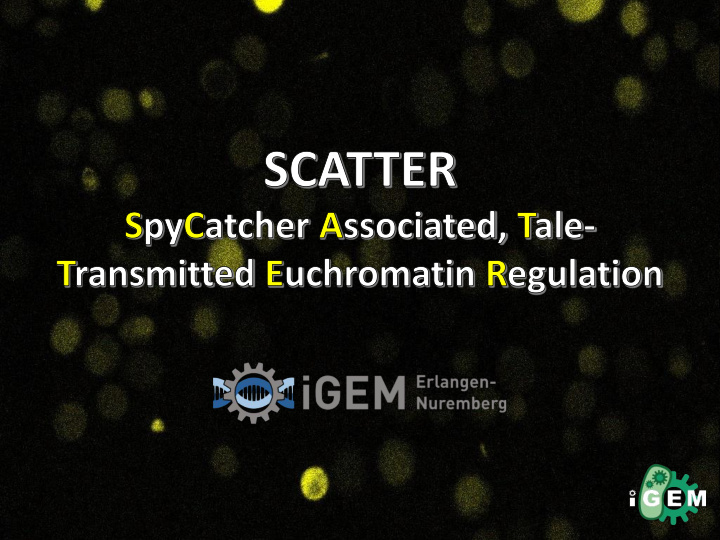



• „ Nuclear inheritance which is not based on differences in the DNA sequence “ (Holliday, 1994) • chromatin structure influences gene expression • modulated by histone modifications • modifications are catalyzed by enzymes • alterations influence cellular differentiation 2
• chromatin structure influences gene expression • modulated by histone modifications • modifications are catalyzed by enzymes • alterations influence cellular differentiation 3
• chromatin structure influences gene expression • modulated by histone modifications • modifications are catalyzed by enzymes • alterations influence cellular differentiation 4
• sequence specific recruitment of a histone modifying enzyme to influence gene expression histone modifying DNA- binding 5
6
• alters as a complex chromatin structure by deacetylation regulates gene expression • could be artificially recruited in S. cerevisiae • homologous to a human deacetylase HDAC1 • recuitment sequence specific in the cell • hardly any off-target activity 7
• transcription activator-like effector • originally found to induce gene expression by binding specific promotor regions ( AvrBs3 in Xanthomonas ) • two constant domains and one variable domain • binds to specific target sequences • „TALE code “ enabling creation of custom TALEs (Boch et al ., 2009) 8
• created TALEs binding specific purposefully targeted DNA sequences in the promoter • recruitment of enzymes to specific sequences to alter chromatin structure and thereby gene expression 9
• same thing with demethylases and enhancers … 10
• SpyTag – SpyCatcher • form a covalent bond • avoiding fusion proteins Veggiani et al., Superglue from bacteria: unbreakable bridges for protein nanotechnology , Cell, 2014 11
12
13
14
Advantages • new approach beyond the possibilities of RNAi pre-transcriptional • specific targeting • modular system enables targeting of several genes 15
16
17
18
19
• eYFP Glühgü seq CMV promoter eYFP cds Adh1 terminator • Rpd3 rpd3 promoter SpyCatcher rpd3 cds Adh1 terminator • TALE rpd3 promoter TALE cds SpyTag Adh1 terminator • two TALES binding within promoter • one binding an artificial sequence found via brute force method confirmed by BLAST 20
K699 (negative) YIYFP (positive) 22
K699 (negative) YIYFP with T1 YIYFP (positive) YIYFP with R 23
K699 (negative) YIYFP with T1 YIYFP with RT1 YIYFP with RT2 YIYFP (positive) YIYFP with R YIYFP with RT3 24
n = 2 25
• CMV-promoter is active in S. cerevisiae (K699) • SCATTER appears to induce gene knockdown 26
Further testing • protein detection • state of acetylation • change of chromatin state • insert eYFP into different gene loci • other chromatin-modifying enzymes • test in cell culture and plants • insert proteins directly Application • cancer: downregulation of oncogenes 27
• board game in collaboration with iGEM Marburg • investigation of evolutionary processes and the construction of a cell • cell components are gained during the game • mutations can be acquired • compared to medieval castle age 10+ 28
• modular system of DNA-binding domain and chromatin-modifying enzyme linked by SpyTag- SpyCatcher • insertion of eYFP and regulatory constructs into yeast • our aim: downregulation of target gene eYFP • result: knockdown of eYFP transcription • human practice: board game for children 29
• our instructors: Prof. Dr. Uwe Sonnewald, PhD student Marlene Pröschel • our advisor: Prof. Dr. Christian Koch • division of Molecular Plant Physiology (clsm) • host labs • sponsors 30
Recommend
More recommend